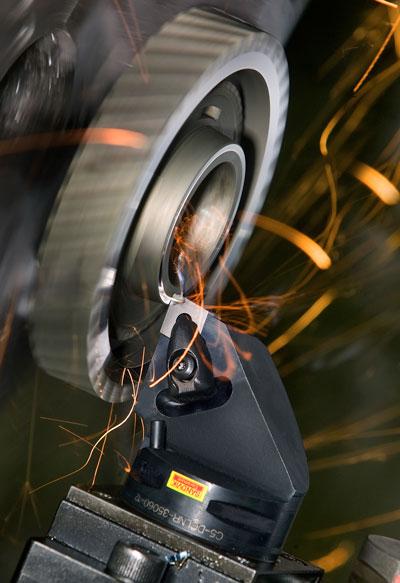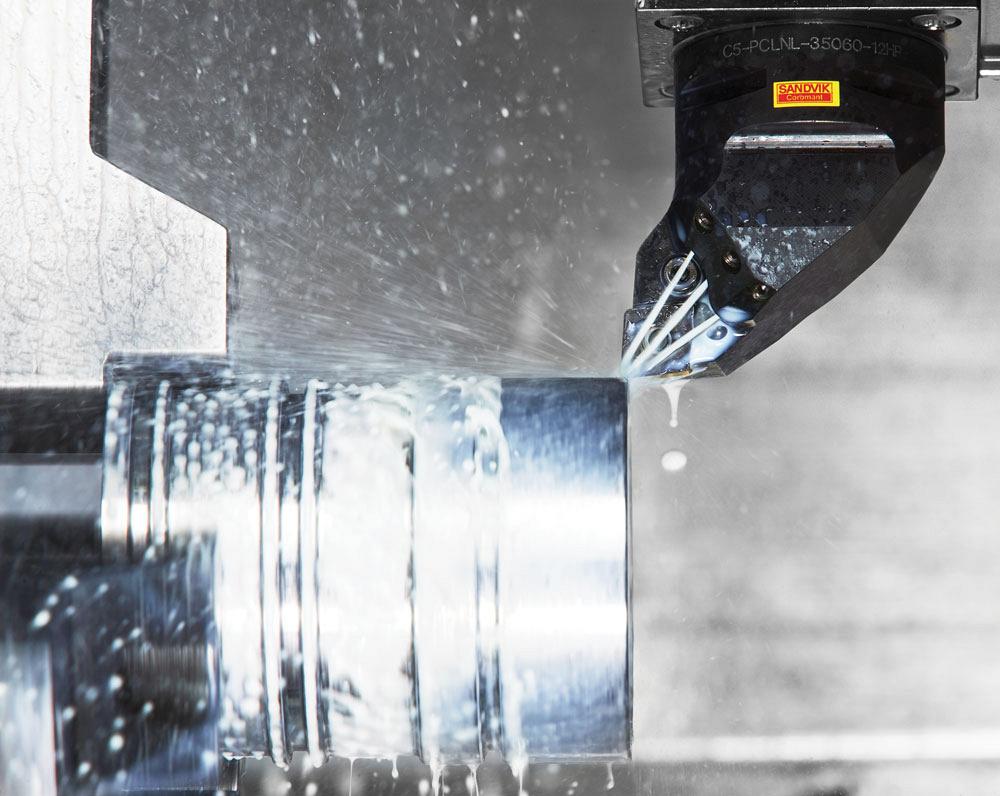- FMA
- The Fabricator
- FABTECH
- Canadian Metalworking
Addressing the P25 Steel Turning Challenge
Evolving demands in steel turning operations require tools that can keep pace
- August 29, 2015
- Article
- Management

The CoroTurn RC is suitable for turning large steel components. It can also be used for internal turning of large-diameter holes in which chip evacuation is good. Photo courtesy of Sandvik Coromant Canada.
Steel turning in ISO P25 materials is the mainstay of operations at machine shops the world over. Optimized processes are a prerequisite in a fiercely competitive global marketplace, and production engineers are continually looking for ways to deliver competitive advantage.
So what are the key issues engineers face in this critical area, and how can tool manufacturers and material development help solve these challenges to deliver an optimized process?
Assessing the Requirement
As an operation, steel turning needs to address and balance many factors. These include maximized output, extended and more predictable tool life, high reliability for limited or unmanned supervision, guaranteed surface quality, and the ability to accommodate the entire large and varied P25 material classification. Of particular importance is the condition of the edge line. If this is broken, rapid breakdown occurs that can result in unacceptable parts and loss of machining security.
First of all, it should be noted that ISO P25 steel is not a straightforward material classification when it comes to cutting tool options. Parts, processes, features, and machining conditions vary widely in this general turning category, which can include operations from roughing to finishing on out-of-round or near-net-shape cast or forged parts. Then there is the material, which might be unalloyed or highly alloyed, with hardness values that differ.
With so many variables affecting the cutting tool insert performance, sourcing a single grade to accommodate the wide-ranging demands of P25 can be a thankless task. Indeed, there are many prerequisites for any grade making such claims. For instance, fracture resistance is paramount, as is a cutting edge capable of delivering the hardness needed to resist any plastic deformation induced by the extreme temperatures present in P25 cutting zones. Furthermore, the insert coating must be able to prevent flank wear, crater wear, and edge buildup. Crucially, the coating must also adhere to the substrate. If the coating fails to stick, the substrate is exposed, leading to rapid failure.
In all instances, the optimum wear pattern for any insert is controlled flank wear because it results in predictable cutting edge life. The ideal grade is one that limits the development of unwanted types of wear— and in some operations, prevents it from developing at all.
Edge Benefits
In today’s high-paced steel turning arena, the life of an indexable insert depends on it having an intact edge line to cut the metal effectively and produce a satisfactory finish. Limiting continuous, controllable wear and eliminating discontinuous, often uncontrollable wear is the secret of success. This is why insert grade manufacturers work hard to produce materials that tackle the mechanisms leading to premature breakdown. And to do this, they must examine the individual types of wear.
Flank wear essentially is abrasive wear on the clearance face below the edge line. It is the natural erosion of the tool material that takes place during the metal cutting process; it is acceptable if it’s allowed to develop in a controlled manner. In some documented cases, the development of balanced flank wear has even been advantageous to the cutting process. However, if flank wear occurs too rapidly, then some of the machining parameters require adjusting, either in the process or the grade.
Crater wear, the other common type of controllable wear, occurs in steel turning because of the effect of heat and pressure. Excessive development can lead to a change of insert geometry, resulting in an inferior cutting process. In time, this leads to edge weakening, and as such presents a major risk to successful machining.
Controlled Wear Patterns
Both flank wear and crater wear are natural and common in steel turning, and as long as it is only these wear patterns being developed—and controlled—the machining process is satisfactory, with the caveat of achieving sufficiently high cutting speeds and tool life.

The fixed nozzles of the CoroTurn HP improve chip control, process security, and productivity in many materials, including ISO P metals.
Of course, complete predictability is a utopian situation that in reality isn’t easy to achieve, particularly considering the current market trend in machining with limited or no supervision. This presents many potential hazards as discontinuous wear types are harder to control. In an ideal world, a cutting tool insert grade for P25 steel turning would be able to resist all types of discontinuous wear during machining within recommended parameters, making true lights-out, unmanned metal cutting operations possible.
A good example of discontinuous wear is plastic deformation, in which the cutting edge is depressed. This is a wear type that develops if the temperature is too high for the grade being deployed. It may start with several small thermal cracks appearing across the cutting edge, or with the coating flaking away from the edge to leave an exposed substrate. This type of failure mechanism can lead to rapid process breakdown, a truly uncontrollable and unacceptable situation.
Trade-off
Often it is a matter of achieving a trade-off that balances the rate of continuous and discontinuous wear to achieve maximum cutting edge security over a long tool life with high cutting data. This notion starts to embrace the overlapping zones of the harder P15 and tougher P35 classifications. Also, in steel turning applications, other tool factors that determine outcome should also be considered, such as insert microand macrogeometry, nose radius, and insert size and shape. It is the combination of these with the insert grade that will determine success, as almost any machinist can make good use of a high-performing P25 grade.
In truth, ISO P25 materials are difficult to cut. That’s why engineers are continually searching for keys that help them deliver improved, benchmarked performance from just one insert grade. As well as improving cutting speeds, these grades should ideally help to improve process security and tool life. In this way, the right insert can contribute to productivity increases that in turn give a competitive advantage.
subscribe now


Keep up to date with the latest news, events, and technology for all things metal from our pair of monthly magazines written specifically for Canadian manufacturers!
Start Your Free Subscription- Trending Articles
- Industry Events
MME Winnipeg
- April 30, 2024
- Winnipeg, ON Canada
CTMA Economic Uncertainty: Helping You Navigate Windsor Seminar
- April 30, 2024
- Windsor, ON Canada
CTMA Economic Uncertainty: Helping You Navigate Kitchener Seminar
- May 2, 2024
- Kitchener, ON Canada
Automate 2024
- May 6 - 9, 2024
- Chicago, IL
ANCA Open House
- May 7 - 8, 2024
- Wixom, MI














